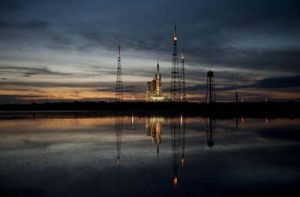Scrub-a-dub-dub
The scrub of today’s Ares I-X launch, now scheduled for 8:00 a.m. tomorrow, October 28, is a good reminder of all that can go wrong when launching a new rocket. But the problems that led to today’s scrub didn’t involve any of the vehicle’s technologies, unless you include a lanyard trying to pull o…
The scrub of today's Ares I-X launch, now scheduled for 8:00 a.m. tomorrow, October 28, is a good reminder of all that can go wrong when launching a new rocket. But the problems that led to today's scrub didn't involve any of the vehicle's technologies, unless you include a lanyard trying to pull off a stuck probe cover on the tip of the vehicle. The bungee-type cord had to be unceremoniously stretched, probably by people with advanced engineering degrees, for a few minutes until it snapped away. The applause in the room, audible on NASA TV, left a colleague and me amused.
Mainly, today's culprit was the threat of bad weather, including upper level winds at the altitude where the vehicle would encounter maximum dynamic pressure; and an atmospheric condition that causes static electricity to build up on the outside of the vehicle as it flies, which would block the ground controllers' ability to destroy the I-X if it flew off course. These passed, and when everything looked great and the clock was ticking again, with just a few minutes to go, the Homer Simpson of cargo ships strayed into the restricted waters east of the launch site, triggering a hold until bad weather could return...

Part of me—no, all of me—fully expected a scrub, having grown up in an era when only two of every five shuttle flights launched on the first attempt, and almost one in ten required more than four attempts. The two humdingers that share the record: STS-61C in 1986, and STS-73 in 1995. Each left on the seventh try. Last July, STS-127 made a run at tying them, but Endeavour got off on the sixth effort.
Granted, shuttle launches are forced to rely on good weather at emergency landing spots around the globe. And some shuttles that, for example, chase down the International Space Station have a launch window of just a few minutes.
But scrubs ain't cheap. NASA admits that each time they fuel and drain a shuttle, $500,000 goes up in hydrogen and oxygen vapors, and $700,000 in personnel costs.
It's worth mentioning that between November 1967 and May 1973, NASA launched 13 Saturn V rockets (including Skylab), 10 of them manned, and not a single launch was ever scrubbed. Apollo 14 saw a brief delay due to weather, and Apollo 17 saw one due to a computer glitch. But no astronaut ever unbuckled from a Saturn V on launch day and took the elevator down.
Was that just the "go fever" of the Apollo era? After Apollo 11 had met JFK's deadline, NASA still launched Apollo 12 into a driving rain. When the rocket was struck by lighting half a minute later, the crew rebooted their pinwheeling control panels and flew on.
But the stakes are sky-high for NASA and Ares right now. The thought of a catastrophe on the first Ares flight is awful. They did the right thing today.
Mainly, today's culprit was the threat of bad weather, including upper level winds at the altitude where the vehicle would encounter maximum dynamic pressure; and an atmospheric condition that causes static electricity to build up on the outside of the vehicle as it flies, which would block the ground controllers' ability to destroy the I-X if it flew off course. These passed, and when everything looked great and the clock was ticking again, with just a few minutes to go, the Homer Simpson of cargo ships strayed into the restricted waters east of the launch site, triggering a hold until bad weather could return...

Part of me—no, all of me—fully expected a scrub, having grown up in an era when only two of every five shuttle flights launched on the first attempt, and almost one in ten required more than four attempts. The two humdingers that share the record: STS-61C in 1986, and STS-73 in 1995. Each left on the seventh try. Last July, STS-127 made a run at tying them, but Endeavour got off on the sixth effort.
Granted, shuttle launches are forced to rely on good weather at emergency landing spots around the globe. And some shuttles that, for example, chase down the International Space Station have a launch window of just a few minutes.
But scrubs ain't cheap. NASA admits that each time they fuel and drain a shuttle, $500,000 goes up in hydrogen and oxygen vapors, and $700,000 in personnel costs.
It's worth mentioning that between November 1967 and May 1973, NASA launched 13 Saturn V rockets (including Skylab), 10 of them manned, and not a single launch was ever scrubbed. Apollo 14 saw a brief delay due to weather, and Apollo 17 saw one due to a computer glitch. But no astronaut ever unbuckled from a Saturn V on launch day and took the elevator down.
Was that just the "go fever" of the Apollo era? After Apollo 11 had met JFK's deadline, NASA still launched Apollo 12 into a driving rain. When the rocket was struck by lighting half a minute later, the crew rebooted their pinwheeling control panels and flew on.
But the stakes are sky-high for NASA and Ares right now. The thought of a catastrophe on the first Ares flight is awful. They did the right thing today.